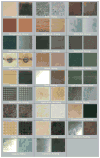The role of color in recognizing material changes
- PMID: 20883347
- PMCID: PMC3552390
- DOI: 10.1111/j.1475-1313.2010.00722.x
The role of color in recognizing material changes
Abstract
The chemical and physical properties of objects provide them with specific surface patterns of color and texture. Endogenous and exogenous forces alter these colors and patterns over time. The ability to identify these changes can have great utility in judging the state and history of objects. To evaluate the role of color cues in this process, we used images of 26 materials undergoing real changes. Observers were asked to identify materials and types of changes for color and gray-scale images. The images were shown in three sets; one image of the surface, two images of the same surface before and after a natural change, and image sequences of the time-varying appearance. The presence of color cues improved performance in all conditions. Identification of materials improved if observers saw two states of the material, but the complete image sequence did not improve performance.
© 2010 The Authors, Ophthalmic and Physiological Optics © 2010 The College of Optometrists.
Figures





Similar articles
-
Visual inferences of material changes: color as clue and distraction.Wiley Interdiscip Rev Cogn Sci. 2011 Nov;2(6):686-700. doi: 10.1002/wcs.148. Epub 2011 May 4. Wiley Interdiscip Rev Cogn Sci. 2011. PMID: 23833699 Free PMC article. Review.
-
Color constancy in natural scenes with and without an explicit illuminant cue.Vis Neurosci. 2006 May-Aug;23(3-4):351-6. doi: 10.1017/S0952523806233285. Vis Neurosci. 2006. PMID: 16961966
-
Color improves edge classification in human vision.PLoS Comput Biol. 2019 Oct 18;15(10):e1007398. doi: 10.1371/journal.pcbi.1007398. eCollection 2019 Oct. PLoS Comput Biol. 2019. PMID: 31626643 Free PMC article.
-
Location and color biases have different influences on selective attention.Vision Res. 2009 May;49(9):996-1005. doi: 10.1016/j.visres.2009.03.013. Epub 2009 Mar 24. Vision Res. 2009. PMID: 19324066
-
Color and material perception: achievements and challenges.J Vis. 2010 Dec 27;10(9):19. doi: 10.1167/10.9.19. J Vis. 2010. PMID: 21187347 Free PMC article. Review.
Cited by
-
Unsupervised learning reveals interpretable latent representations for translucency perception.PLoS Comput Biol. 2023 Feb 8;19(2):e1010878. doi: 10.1371/journal.pcbi.1010878. eCollection 2023 Feb. PLoS Comput Biol. 2023. PMID: 36753520 Free PMC article.
-
Core dimensions of human material perception.Proc Natl Acad Sci U S A. 2025 Mar 11;122(10):e2417202122. doi: 10.1073/pnas.2417202122. Epub 2025 Mar 5. Proc Natl Acad Sci U S A. 2025. PMID: 40042912 Free PMC article.
-
Identifying shape transformations from photographs of real objects.PLoS One. 2018 Aug 16;13(8):e0202115. doi: 10.1371/journal.pone.0202115. eCollection 2018. PLoS One. 2018. PMID: 30114202 Free PMC article.
-
Visual inferences of material changes: color as clue and distraction.Wiley Interdiscip Rev Cogn Sci. 2011 Nov;2(6):686-700. doi: 10.1002/wcs.148. Epub 2011 May 4. Wiley Interdiscip Rev Cogn Sci. 2011. PMID: 23833699 Free PMC article. Review.
-
Luminance distribution modifies the perceived freshness of strawberries.Iperception. 2012;3(5):338-55. doi: 10.1068/i0471. Epub 2012 May 21. Iperception. 2012. PMID: 23145288 Free PMC article.
References
-
- Adelson EH. On seeing stuff: the perception of materials by humans and machines. Proc Soc Photo Opt Instrum Eng. 2001;4299:1–12.
-
- Adelson EH, Li Y, Sharan L. Image statistics for material perception. J Vis. 2004;4:123.
-
- Dorsey J, Pedersen HK, Hanrahan P. Flow and changes in appearance. International Conference on Computer Graphics and Interactive Techniques; New York, NY: ACM; 2005.
-
- Gegenfurtner KR, Rieger J. Sensory and cognitive contributions of color to the recognition of natural scenes. Curr Biol. 2000;10:805–808. - PubMed
-
- Gu J, Tu CI, Ramamoorthi R, Belhumeur P, Matusik W, Nayar S. Time-varying surface appearance: acquisition, modeling and rendering. International Conference on Computer Graphics and Interactive Techniques; New York, NY: ACM; 2006. pp. 762–771.
Publication types
MeSH terms
Grants and funding
LinkOut - more resources
Full Text Sources

